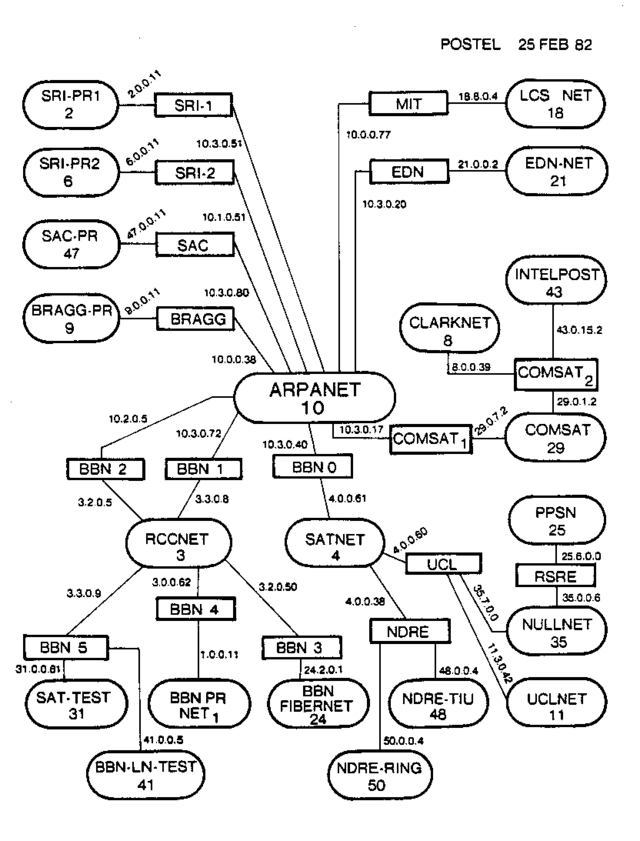Classful network: Difference between revisions - Wikipedia
 Article Images
Article Images
m
(25 intermediate revisions by 17 users not shown)Line 3:
[[Image:Internet map in February 82.png|thumb|300px|Map of the prototype Internet in 1982, showing 8-bit-numbered networks (ovals) only, interconnected by [[Router (computing)|router]]s (rectangles).]]
A '''classful network''' is an obsolete [[network address]]ing architecture used in the [[Internet]] from 1981 until the introduction of [[Classless Inter-Domain Routing]] (CIDR) in 1993. The method divides the [[IP address]] space for [[IPv4|Internet Protocol version 4]] (IPv4) into five address classes based on the leading four address bits. Classes A, B, and C provide [[unicast]] addresses for networks of three different network sizes. Class D is for [[multicast]] networking and the class E address range is reserved for future or experimental purposes.
Since its discontinuation, remnants of classful network concepts have remained in practice only in limited scope in the default configuration parameters of some network software and hardware components, most notably in the default configuration of [[subnet mask]]s.
Line 15:
| first = David D. | last = Clark
|date=June 1978
| publisher = [[Internet Engineering Task Force|IETF]]
| access-date = 2014-01-08
}}</ref> As a result, some organizations involved in the early development of the Internet received very large address space allocations far larger than they would ever need (16,777,216 IP addresses each). It became clear early in the growth of the network that this would be a critical [[scalability]] limitation.{{citation needed|date=March 2018}}
==Introduction of address classes==
Line 28:
The leading bit sequence ''111'' designated an at-the-time unspecified addressing mode ("''escape to extended addressing mode''"),{{Ref RFC|791|repeat=yes}} which was later subdivided as Class D (''1110'') for multicast addressing, while leaving as reserved for future use the ''1111'' block designated as Class E.{{Ref RFC|988}}
This architecture change extended the addressing capacity of the Internet but did not prevent [[IPv4 address exhaustion|IP address exhaustion]]. The problem was that many sites needed larger address blocks than a Class C network provided, and therefore they received a Class B block, which was in most cases much larger than required. Due to the rapid growth of the Internet, the pool of unassigned Class B addresses (2<sup>14</sup>, or about 16,000) was rapidly being depleted. Starting in 1993, classful networking was replaced by [[Classless Inter-Domain Routing]] (CIDR),{{Ref RFC|1518}}{{Ref RFC|1519}} in an attempt to solve this problem.
==Classful addressing definition==
Under classful network addressing, the 32-bit IPv4 address space was partitioned into 5five classes (A-E) as shown in the following tables.
;Classes
{| class="wikitable"
Line 102:
| 268,435,456 (2<sup>28</sup>)
| {{IPaddr|240.0.0.0}}
| {{IPaddr|255.255.255.255}}{{efn|{{IPaddr|255.255.255.255}} is reserved as the IPv4 [[Broadcastbroadcast address]].}}
| not defined
| not defined
Line 142:
The number of addresses usable for addressing specific hosts in each network is always {{nowrap|2<sup>N</sup> - 2}}, where N is the number of rest field bits, and the subtraction of 2 adjusts for the use of the all-bits-zero host value to represent the network address and the all-bits-one host value for use as a broadcast address. Thus, for a Class C address with 8 bits available in the host field, the maximum number of hosts is 254.
Today, IP addresses are associated with a [[netmask|subnet mask]]. This was not required in a classful network because the mask was implied by the address itself; any network device would inspect the first few bits of the IP address to determine the class of the address and thus its netmask.
The blocks numerically at the start and end of classes A, B and C were originally reserved for special addressing or future features, i.e., {{IPaddr|0.0.0.0|8}} and {{IPaddr|127.0.0.0|8}} are reserved in former class A; {{IPaddr|128.0.0.0|16}} and {{IPaddr|191.255.0.0|16}} were reserved in former class B but are now available for assignment; {{IPaddr|192.0.0.0|24}} and {{IPaddr|223.255.255.0|24}} are reserved in former class C. While the {{IPaddr|127.0.0.0|8}} network is a Class A network, it is designated for [[loopback]] and cannot be assigned to a network.<ref name="RFC 5735">{{cite IETF |title=Special Use IPv4 Addresses |author1=M. Cotton |author2=L. Vegoda |date=January 2010 |RFC=5735}}</ref>